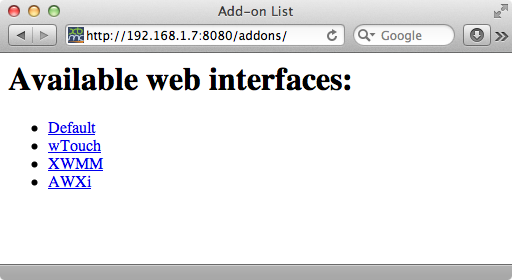Web interface
Web interfaces allow users to control and interact with their Kodi installation through a web browser. This can be used for a remote control, library management, visual feedback, and many other things.
Turning on the web interface
The webserver is disabled by default and has to be manually enabled by the user. This can be done in Settings → Services → Control → Allow remote control via HTTP. The settings allow to specify a custom port number and an optional username and password for HTTP's Basic Access Authentication. Furthermore a Web interface can be chosen which will be used when accessing the webserver without any specific path.
Using the web interface
There are two options to use any given web interface:
Default web interface
To set a web interface add-on as the default web UI, go to System -> Services -> Control and select that add-on for the Default value. Then go to the hostname (or IP address) of that HTPC+Port number.
Note: Some platforms use port 80, which is the assumed port if no port is given in the address.
For example, http://10.0.0.3:8080 or http://192.168.1.7
Using multiple web interfaces at once
Let's say http://123.4.5.6:8080 is your local IP for accessing your default web interface add-on. You can access the other web interface add-ons you have installed by going to http://123.4.5.6:8080/addons/ where you will see a directory listing.
For example, http://10.0.0.3:8080/addons/ or http://192.168.1.7/addons/
Manually enabling remote control
If you have installed Kodi on a device and it has started up in Kodi, and you either have SSH access or other access to the Kodi userdata folder, you can manually enable remote control. This is helpful in a few situations, for example: If you have a networked device but no physical remote control (left it at home, can't find the dang remote, etc), you can still use the web interface or a smartphone/tablet app to control Kodi.
There are two basic ways to do this:
guisettings.xml -
- Normally you do not want to manually edit the guisettings.xml file. In this case it should be "safe", but only change these settings from
falsetotrue, and don't edit other things.- Edit the guisettings.xml file in the userdata folder and look for the following settings under "
<services>", and make sure they are set to "true". You'll have to look for them a little bit, because there among several other settings. Assuming you have not set a password or changed other default settings, this should work:- <esallinterfaces> - true
- <webserver> - true
- <zeroconf> - true
- Save the file and restart Kodi.
- Edit the guisettings.xml file in the userdata folder and look for the following settings under "
- While using an advancedsettings.xml file might be easier to enable these services, doing so will hide them from the normal Kodi GUI. You will have to remove or edit the advancedsettings.xml file to turn these settings back off, which can be confusing later on if you forgot you have an advancedsettings.xml file.
- Create a plain text file (no rich text formatting, don't use .doc, etc) and save it as advancedsettings.xml. Make sure that the file extension is ".xml" and not ".txt" or ".xml.txt".
- Cut and paste this into your new plain text file:
<advancedsettings> <services> <esallinterfaces>true</esallinterfaces> <webserver>true</webserver> <zeroconf>true</zeroconf> </services> </advancedsettings>
- Save this file in your userdata folder
- Note: If you have an existing advancedsettings.xml file, make sure the tags are between the main
<advancedsettings></advancedsettings>tags.
- Note: If you have an existing advancedsettings.xml file, make sure the tags are between the main
- Restart Kodi.
| userdata folder location: | ||||||||||||||||||||||||||||
|---|---|---|---|---|---|---|---|---|---|---|---|---|---|---|---|---|---|---|---|---|---|---|---|---|---|---|---|---|
|
The Userdata folder is a subfolder of the Kodi Data Folder and is located as shown in the table below.
|
